‘You cry a lot’: Inside the world of Qld’s most heart-wrenching job
Lovingly swaddled, the baby in the fridge looked perfect. Doting on the stillborn infant are women who choose to help families through the most traumatic time of their life. Now they give insight into the harrowing job and how they bring light to the darkness.
QWeekend
Don't miss out on the headlines from QWeekend. Followed categories will be added to My News.
WARNING: Distressing content
The baby in the fridge looked perfect.
Lovingly swaddled and tucked into a bassinet, his little eyes closed, a blue and white beanie adorned his head.
Another boy lay inside a tiny handmade coffin nearby, his name and a single flower placed on top.
The infants, stillborn at 39-weeks gestation and 30-weeks gestation respectively, were two of four children waiting for their heartbroken parents to say their final farewells during a recent November morning.
A five-month-old twin girl, a victim of Sudden Infant Death Syndrome (SIDS) and a tiny little boy, born at 23-weeks-gestation, kept them company in the large walk-in refrigerator at the back of the Farewell Funerals home in Meadowbrook.
The cool room was cold, but the environment was otherwise lovingly warm.

Funeral home owner Shelly Magyar, 62, her daughter Tamara Greig, 33, and Rachel Durre-Hart, 44, each having lost babies of their own, dote on the infants and tend to their grieving families with gentle compassion.
The four were among the seven deceased babies, on average, the ladies pick up each week from devastated parents at Brisbane and Gold Coast area hospitals or from the State Coroner’s office, depending on the cause of death.
It’s an emotionally difficult job and some days are worse than others.
“It doesn’t happen very often, but we recently picked up 12 babies in one day,” Shelly says as she sits in an armchair in the front parlour.
“It was about six to 10 months ago. Usually, we average about seven a week.”
The women say they do not know why there were so many babies on that terrible day.

Shelly, of Cornubia, Tamara, of Runaway Bay, and Rachel, of Waterford West, are just some of the people who choose to work in a heartbreaking industry that helps families through the most traumatic days and weeks of their lives after losing a child.
They are part of a broader network of organisations that work together to support grieving parents by sending them everything from memorial items to lists of support groups and more.
In most cases, those involved in the industry have experienced loss themselves, either through miscarriage, stillbirth or in other ways, such as SIDS, after taking their baby home.
These personal experiences mean they understand how important it is for traumatised parents to have adequate support at such a sensitive time.
More than 310,000 babies are born in Australia every year, with about 2200 of those infants – or six children every day – stillborn, according to the government-funded Still Six Lives public awareness and education campaign launched in 2021.
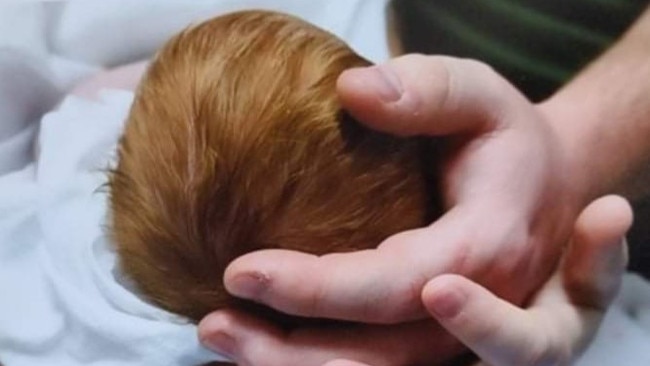
Besides the six, two other babies, on average, pass away within 28 days of birth nationally, according to a recent Australian Institute of Health and Welfare report into stillbirths and neonatal deaths.
Once the babies arrive at the small funeral home in Logan, south of Brisbane, families have the option to visit their son or daughter in a loungeroom-like viewing room.
To the right of the Farewell Funerals entry foyer, a white wooden door opens into the rectangular-shaped private space where families are able to spend their last precious moments with their lost child.
A lone white bassinet sits in the far right corner, across from a 2m tall dark brown teddy bear.
Tea lights inside giant, wooden lantern decorations ensure tranquil lighting, while two chairs and a small lounge embellished with more teddy bears complete the room.

Rachel says unless the parents have had access to a cuddle cot, it’s often the first time they have been able to spend some peaceful time with their baby following the shock and trauma of the birth.
A cuddle cot, a bassinet-shaped cooling system, is designed to help preserve a body longer and provides families with the option of taking their child home for a few days before their service to help them mourn.
“A couple of weeks ago a couple said, ‘This is the first time we felt like parents’,” Rachel says.
“They felt like they were in their own lounge room.”
Upstairs in the office sits a new cuddle cot, donated by Nikki Hufton and Aaron Harrison in memory of their daughter Sophie Judith, who was “born sleeping” on August 10.
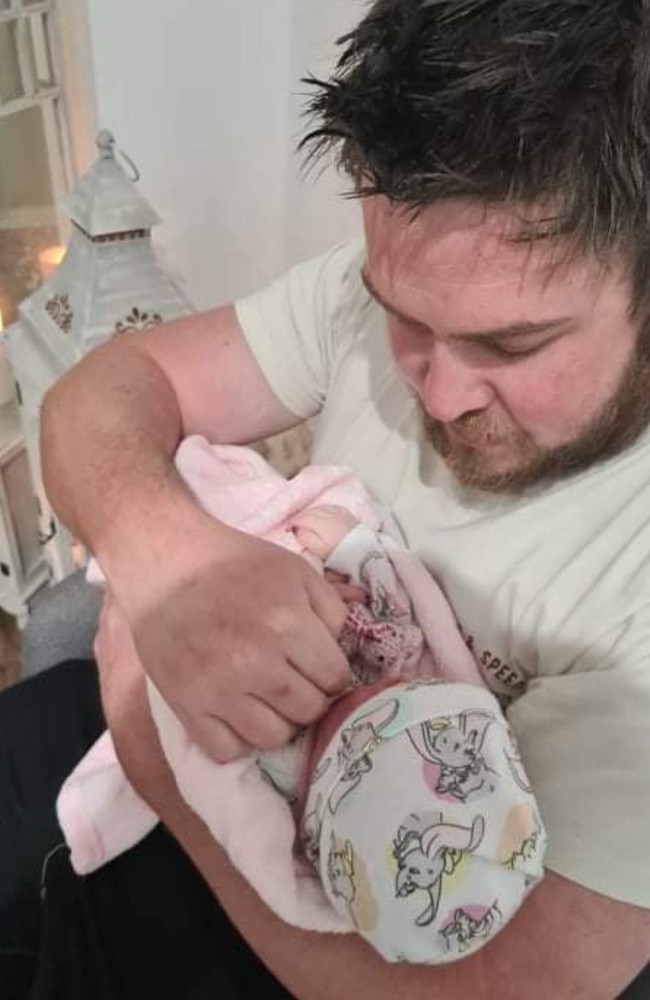
The three funeral directors gently try to encourage families to spend some time they’ll never get back with their loved one.
“It wasn’t like this years and years ago,” says Shelly, who miscarried her second child in 1985.
“The doctor just said … take this pill, go home and put your feet up.
“It’s dismissed and you’re out that door.”
In shock, she says she did not tell most people.
“I felt at that time it was something you didn’t talk about.
“But the feeling of being completely dismissed – that stayed with me.”
They are grateful for modern support services, which include professional photographers capturing the family’s final moments, groups that offer hand and feet plaster casts, to other organisations that send memory boxes full of special mementos.
Rachel, who lost her own daughter at 39 weeks prior to working at Farewell Funerals, is sad if a parent chooses to not see, and especially hold, their baby one last time.
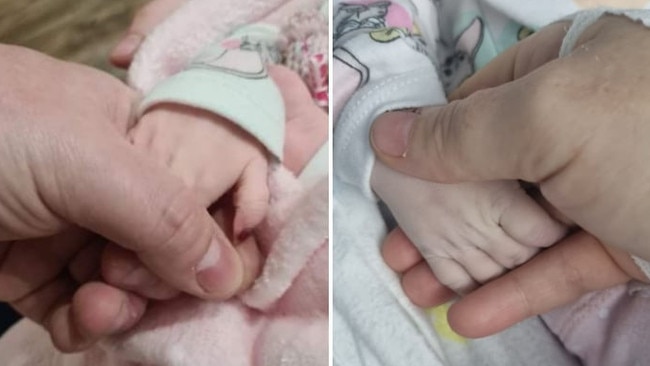
It’s an opportunity she would have cherished with her daughter, but says the directors of a (different) funeral home Ada was cremated at never told her it was an option.
Discovering she missed out on seeing Ada again was the catalyst for Rachel becoming a funeral director, to help ensure others did not experience the additional heartache of unknowingly missed opportunity.
But, she says, it is not always easy for some parents to see their deceased children again.
“People dread coming here. They don’t know what condition their baby’s going to be in and don’t know what to expect,” Rachel says.
“I guess anticipation is worse than reality. You don’t know what the baby is going to look like.”
Some infants arrive into care looking like they are sleeping, while others need a bit of help from an embalmer to ensure they look perfect for their viewing.
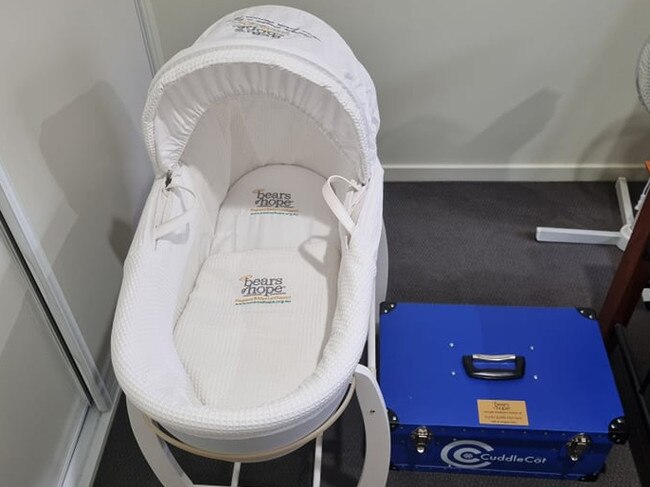
In some cases, parents are relieved to discover their child’s appearance is better than when they last saw them at the hospital.
One grieving mother who came to the funeral home with her aunt refused to even look at her son, Rachel says.
“She didn’t want to know anything about him,” she says.
“Her friend called to make arrangements. We picked up the baby a couple of days after she gave birth.
“In that initial traumatic stage you’re not making clear decisions. Sometimes it helps if you sleep on it.
“Mum stayed out here while the aunt held him,” she says, pointing to the armchairs near the door.
“He was swaddled, so she showed her his face from the doorway of the viewing room.”
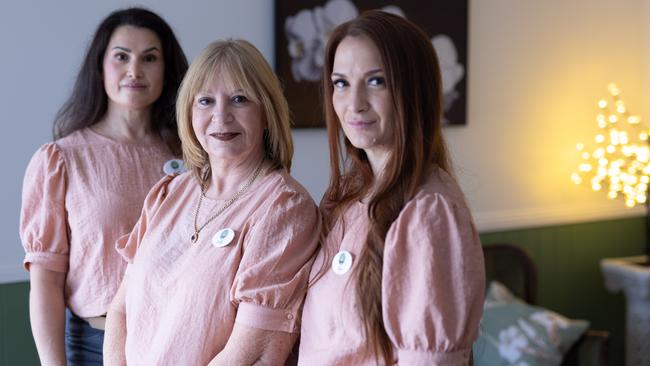
After about an hour of watching her aunt trying to coax her into the room to see her son, Rachel says the woman finally relented.
“For many, a dead person is scary and a dead baby is very traumatic,” she says.
“She just needed that time to get used to the baby, to make it more normal.”
Shelly says the mum later thanked them.
“She finally went in. She undressed him, played with his toes and fingers. She knew every little part of that boy,’ she says.
“And you could just see the delight in her face that she had spent time with her son.
“That’s why we don’t rush people. You’ll change your mind.”
Rachel says the mum even returned another day to visit her son again after that initial visit.
“We don’t rush them, as the worst thing is saying goodbye,’ she says.
“How many holds are enough really? You know when the right time is.”
The connection
It was July 2016 when Marianne Stokvold Wuthrich photographed little Peiyton Grace Innes of Redbank Plains during a newborn photo session.
Born on March 13 at 25 weeks gestation, Peiyton spent four months battling for her life in the Brisbane’s Mater Mother’s hospital neonatal intensive care unit (NICU), so parents Natalie Cleary and Hayden Innes were excited to finally take her home on June 11.
Not long after the photo shoot, tragedy struck.
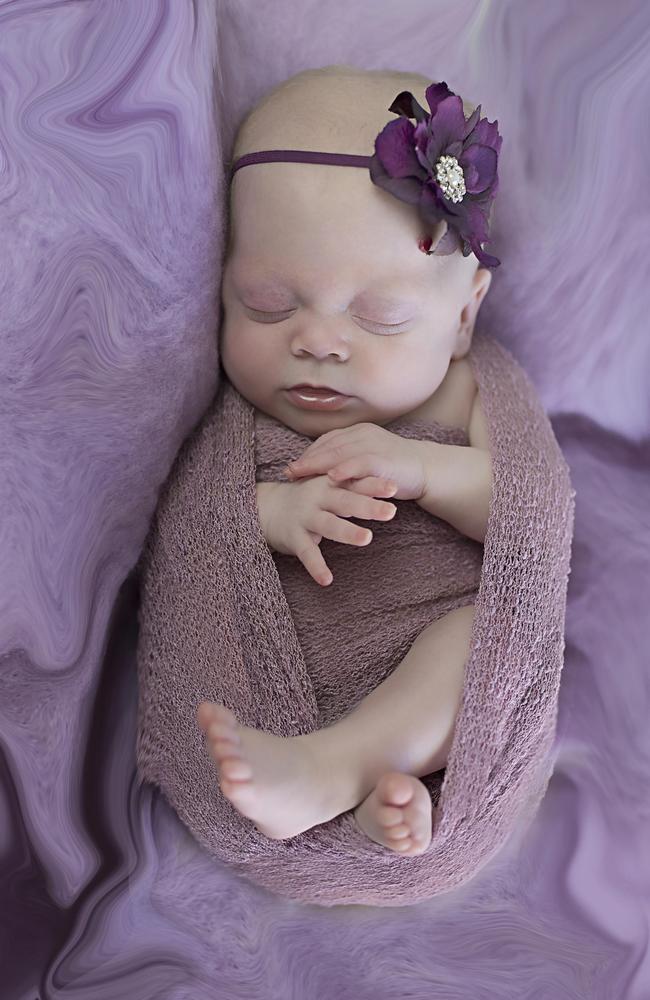
“Not even two weeks later, before the photos were ready, I got a message from the mum asking if they could have the photos earlier as the baby had died of SIDS,” Marianne recounts.
“I thought about it for a day and then offered to take some photos at the baby’s funeral.
“That’s when I started to panic. What did I just offer them? I wasn’t sure it was ‘a thing.’
“I had offered on impulse. It just felt like something I should do … and she said ‘yes please’.”
Marianne, 49, of Kuraby, says she contacted a volunteer from Heartfelt Photography – an organisation of professional photographers who specialise in capturing end-of-life memories of children – and asked for advice on how to take the best photos at a funeral.
She later joined Heartfelt herself because of Peiyton and because her own first child was stillborn at 26 weeks gestation.
“So I thought this was fate. It’s what I’m supposed to do,” she says.

Marianne says some parents are unsure about having photos taken, but are always grateful weeks later.
She mirrors the family and their emotions as best she can during the photo shoots, mostly in hospitals.
Sometimes she has to “push a little bit extra” to get the photographs she feels are needed, no matter how awkward the parents might be feeling.
“I know they want the photos but they can be crying and are so overwhelmed, they don’t know they want them yet,” she says.
The thought of photographing children in their final moments or even holding a dead body can seem frightening and morbid to many people.
But experience has shown Marianne that families later treasure those final photographs.
For some, it might be a simple photo of a hand on a baby, for others, it’s a lifelong connection to shattered dreams.
“I make sure I try to get all the little details, the hair, the nose, lips, and fingers,” she says.
“And, I always try to get the parents’ hand on their baby.
“My personal belief is that I feel it is important for the parents to have touched the baby and have a personal connection.’
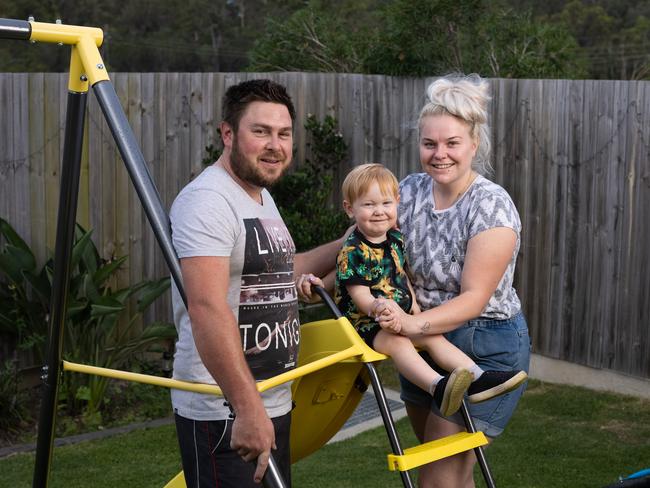
That connection is important, she continues.
“Because that’s the feeling the parents will remember. I’m more aware of that now than when I lost my baby.”
Marianne says seeing the babies can be confronting, as some of them can be covered in blemishes and blisters, their skin can be discoloured, their tiny bodies may have started to deteriorate or they have been born with life-threatening abnormalities.
“It can be a pretty confronting situation,’ she says.
She learnt to ask a nurse about the baby’s condition before entering the room after her very first volunteer photo session, where she was unexpectedly shocked by the baby’s appearance.
“I don’t know what my expression was like, but I pulled myself together,” Marianne recalls.
“The skin was very torn, and there were a lot of blisters … some were so big over his head that it looked like the head was almost double the size.
“I had never seen that before. … I was concentrating very hard to not show my emotions.”
Being prepared before meeting the grieving parents also helps her think of the best way to photograph the family.

Marianne was only 25-years-old when she and husband, Clement, now 50, lost their first child, Sandra, at 26 weeks gestation in her home country of Norway.
At the time, she was shocked the midwives had her hold her dead daughter and surprised when they took a photo on a Polaroid camera.
Within moments, she understood.
“Immediately I was very happy I got to hold her and then later I realised how good that was,’ says Marianne.
“I felt like I had a baby and it was not just some fantasy or fiction or a dream that may or may not have happened.
“I want the families to have some photos and memories because I know, from experience, it’s important to have it.”
Organised with the permission or request of the family, hospital staff members contact Heartfelt’s state representative to schedule the photo shoots.
Although Marianne says she can do the job because she is “very good at pushing her emotions aside”, she finds photographing children about to be taken off life support the most difficult.
“(Those) ones are my worst ones because they have been alive and they are still alive and they might then withdraw care, so I see the child or the baby die, literally,” she says.
“It hits closer to home because I have three (adult) children. These are little people.”

In these cases, the children may have a terminal illness or have been injured in some way.
“It hurts. It’s the worst to see the family having their baby just ripped out of their arms per se,’ Marianne says.
Some days can be more emotionally challenging than others.
When the photos are all taken, and the goodbyes have mostly been said, the children are either taken to a morgue or picked up directly from the parents by people like Shelly, Tamara and Rachel.
“A lot of parents have a fear their baby will just be put in a (body) bag and put in a mortuary,” Shelly says.
“They don’t want to feel like they’re disposing of, or that they’re throwing out their baby, they want to know they are going with someone who actually cares.”
The ladies are discreet as they take the child from the arms of their devastated parents and carry him or her through a back entrance of the hospital ward.
If anyone looked closely enough, it would just look like a sleeping baby being carried in a bedlike infant travel carrier.
It’s a difficult job
The funeral directors try their best to “keep it together” in front of the families but often cry on the way home.
They agree every funeral is different, as are coping strategies.
Shelly, who is also a celebrant, says they learn to be strong in the moments the families are with them.
‘You learn to suppress it,’ she says.
Rachel says she is a ‘crier.’
“I have a 12-minute drive home, so on most car rides home, I’ve got 12 minutes to get it out of my system,’’ she explains.

“It’s heartbreaking. My heart breaks for these families.
“I have a lot of waterproof mascara. I’ve found a really good brand.’
Tamara, who had a miscarriage in 2019, says when she first joined her mum’s business she was worried about how she would handle the profession.
“I didn’t want to be the one crying in the corner,” she says.
“You learn to suppress it, but some funerals are harder than others.”
Although the ladies connect with all of the infants that come through the funeral parlour, Tamara says some inexplicably hit home harder than others.
“We talk to (the babies) and treat them like they’re with us,” she explains.
“About a year or so ago. I collected a little bubby, and I didn’t want to let her go.
“I don’t know what it was. We’d carry around her the office all wrapped up and talk to her.
‘I didn’t want to put her in the fridge.”
The babies that had had a small chance at life got to Tamara the most, she says.
“A little boy we collected the other day was seven weeks old and had died of SIDS.
“He looked like he was sleeping and I could see my youngest like that, like he could just wake up.”
PART ONE: ‘Hospital laid my dead baby in ice packs’: Mum’s stillborn horror



